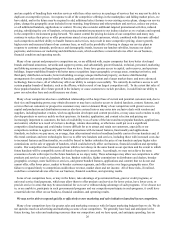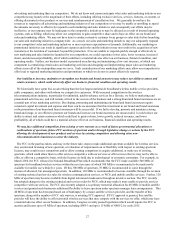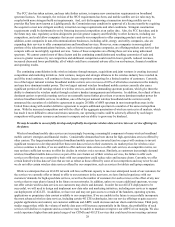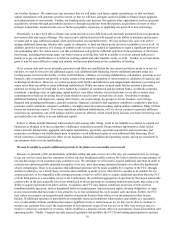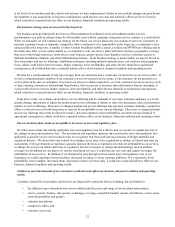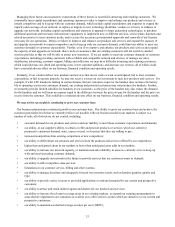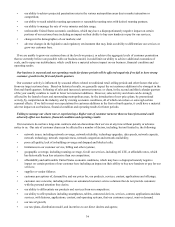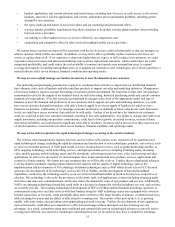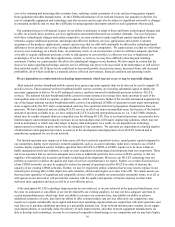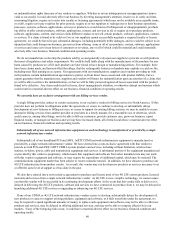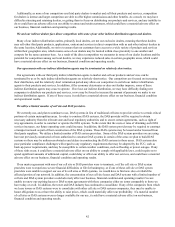Metro PCS 2011 Annual Report Download - page 46
Download and view the complete annual report
Please find page 46 of the 2011 Metro PCS annual report below. You can navigate through the pages in the report by either clicking on the pages listed below, or by using the keyword search tool below to find specific information within the annual report.35
• handset, application, and content selection and related issues, including lack of access, or early access, to the newest
handsets, innovative wireless applications, and content, and handset prices and handset problems, including greater
demand by our customers;
• the types, make-up and nature of our service plans and our marketing and promotional offers;
• wireless number portability requirements that allow customers to keep their wireless phone numbers when switching
between service providers;
• our inability to offer bundled services or services offered by our competitors; and
• competition and competitive offers by other wireless broadband mobile service providers.
We cannot assure you that our churn will be consistent with the levels we have achieved historically or that our strategies to
address customer churn will be successful. In addition, we may not be able to profitably replace customers who leave our
service or replace them at all. If we experience a churn rate higher than we expect, or fail to replace lost customers, we could
experience reduced revenues and increased marketing costs to attract replacement customers, which could reduce our profit
margin and profitability, and could reduce the cash available to construct and operate new metropolitan areas, to expand
coverage and capacity in existing metropolitan areas, or to upgrade our networks to new technologies, all of which could have a
material adverse effect on our business, financial condition and operating results.
We may not successfully manage our handset inventories to meet the demands of our customers.
Our marketing and purchasing personnel are required to coordinate their activities to ensure that our distribution channels
have adequate sales stock of handsets and other ancillary products to support our sales and marketing initiatives. Management
of inventory balances requires accurate forecasting of customer growth and demand. We from time to time enter into purchase
commitments related to the supply of our handsets based on such forecasting, historical purchasing trends and current customer
demands and expectations. If we fail to predict and maintain an adequate sales stock of the appropriate model and type of
handsets to meet the demands and preferences of our customers and to support our sales and marketing initiatives, we could
have excess customer demand for handsets with only a limited supply or an excess supply of handsets for which we have
limited or no demand. Additionally, if we misjudge consumer preferences or demands or future sales do not reach forecasted
levels, we could have excess inventory that could not be sold easily. Further, if we do not have the handsets our customers
want, we could fail to meet our customer's demands, resulting in lost sales opportunities. Any failure to manage and control our
supply inventories, including our purchase commitments, could lead to lower growth, decreased revenues, increased churn,
decreased profitability, and could result in significant write-offs of inventory, inventory sold at prices lower than expected, any
of which could have a material adverse effect on our business, financial condition, and operating results.
We may not be able to respond to the rapid technological changes occurring in the wireless industry.
The wireless telecommunications industry has been, and we believe will continue to be, characterized by significant and
rapid technological change, including the rapid development and introduction of new technologies, products, and services, such
as voice-over Internet protocol, or VoIP, push-to-talk services, location-based services, such as global positioning satellite, or
GPS, mapping technology, social networking services, and high speed data services, including streaming audio, streaming
video, mobile gaming, mobile banking, music and file downloads, advertisement paid services, video conferencing and other
applications. In order to be successful, we must anticipate these trends and develop new products, services, applications and
content in a timely manner. We cannot give any assurance that we will be able to do so. Further, these technological advances,
evolving industry standards, ongoing improvements in the capacity and the quality of digital technology, such as the
implementation and development of 3G technology, wideband technologies such as WiFi which do not rely on FCC-licensed
spectrum, the development of 4G technology, such as 4G LTE or WiMax, and the development of data and broadband
capabilities, could cause the technology used by us on our wireless broadband mobile network to become less competitive or
obsolete. This technology is driven by the prevalence of electronic mail, web applications, content (including streaming audio
and video) and non-voice communications, which may reduce the demand for some of our products and services. Additionally,
VoIP is an emerging technological trend that could result in a decrease in demand for switched telephone services, such as those
we currently provide. The resulting technological development of WiFi or WiMax enabled handsets permitting customers to
communicate using voice and data services with their handset using this VoIP technology in any area equipped with a wireless
Internet connection, or hot spots, could potentially allow more carriers to offer larger bundles of minutes, or unlimited services,
while retaining low prices and the ability to offer attractive roaming rates. The number of hot spots in the U.S. is growing
rapidly, with some major cities and urban areas approaching universal coverage. Further, the development of new equipment,
such as femtocells, could allow our competitors to offer increased usage without increased cost thus reducing our cost
advantage. As a result, competitors using more traditional and commercially proven technological advances to provide service
or using more efficient, less expensive technologies (including those not yet developed), may have a competitive advantage



